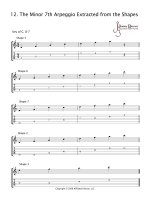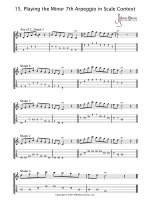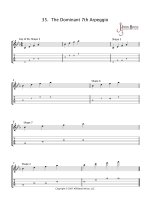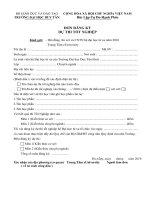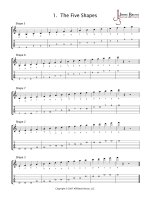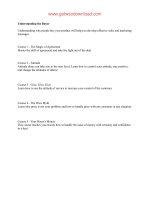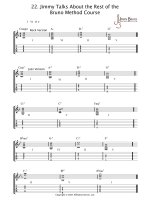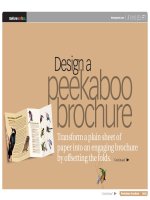LEARN CALLIGRAPHY THE COMPLETE BOOK of LETTERING DESIGN by MARGARET SHEPHERD tủ tài liệu bách khoa
Bạn đang xem bản rút gọn của tài liệu. Xem và tải ngay bản đầy đủ của tài liệu tại đây (15.19 MB, 219 trang )
OTHER BOOKS BY MARGARET SHEPHERD
Learning Calligraphy
Using Calligraphy
Capitals for Calligraphy
Borders for Calligraphy
Calligraphy Made Easy
Calligraphy Projects
Calligraphy Alphabets Made Easy
Calligraphy Now
Reissued as A Manual of Modern Calligraphy
Basics of the New Calligraphy
Basics of Left-Handed Calligraphy
Modern Calligraphy Made Easy
Calligraphy for Celebrating Your wedding
Calligraphy for Celebrating Your Newborn
The Very Small Calligraphy Calendar
The Alphabet Advent Calendar
The ABC Advent Calendar
BROADWAY BOOKS
and its logo, a letter B bisected on the diagonal, are trademarks of Broadway Books, a division of Random House, Inc.
Learn Calligraphy. Copyright © 2001 by Margaret Shepherd. All rights reserved. Printed in the
United States of America. No part of this book may be reproduced or transmitted in any form or by
any means, electronic or mechanical, including photocopying recording or by any information storage
and retrieval system, without written permission from the publisher.
For information, address Broadway Books, a division of Random House, Inc., 1540
Broadway, New York, NY 10036.
Broadway Books titles may be purchased for business or professional use or for special sales. For
information, please write to: Special Markets Department, Random House, Inc., 1745 Broadway,
New York, NY 10019.
Visit our website at www.broadwaybooks.com
ISBN: 0-7679-0732-9
eISBN: 978-0-7704-3459-5
Learn Calligraphy is an expanded revision of the original classic, Learning Calligraphy (1977),
completely rewritten with new text and reillustrated with new calligraphy and new drawings.
v3.1
CONTENTS
Cover
Other Books by Margaret Shepherd
Title Page
Copyright
Acknowledgments
Dedication
Author’s Foreword
THE ALPHAPETS IN THE ALPHABETS
SCRIBES & MATERIALS
THE VOCABULARY OF THE PEN
GETTING STARTED
SEEING CALLIGRAPHY
ROMAN
CELTIC
GOTHIC
GOTHIC CAPITALS
BOOKHAND
ITALIC
ITALIC CAPITALS & SWASHES
NUMERALS & PUNCTUATION
ACKNOWLEDGMENTS
I have been helped by many generous people in the process of writing this book. Those who tried
out the practice exercises early on were particularly kind: students and faculty in Boston University
School for the Arts workshop; members of the Connecticut Valley Calligraphers’ guild; art teachers in
the Framingham Schools in-service course; residents of Hale House; students in the City of Boston’s
Youth Fund Mural Crew; and a group of enthusiasts at the St. Botolph Club. J am grateful to Alston
Purvis, Kathleen Borkowski, Leslie Miller, Jane Poltier, Heidi Schork, and Anita Lincoln for help in
organizing these groups.
I want to thank my agent, Colleen Mohyde of Doe Coover, for helping bring this book to life. I am
most grateful to my editor, Tricia Medved, who always seemed to have a clearer idea of what this
book could become, and kept me at it until I saw it, too. It is a better book because of her.
I am extra grateful to my children—Jasper, Zack, Zoë, and Lily—who coped and cheered and
pitched in, and to my husband, David Friend, who encouraged me all the way along.
The following material is used with the permission of its owners:
Detail from wall painting. M etropolitan M useum of Art, Egyptian Expedition, Rogers Fund, 1930. (30.4.44).
100 Ballads: Christine de Pisan writes. M s. Fr. 835, fol. 1. (detail), Bibliotèque Nationale, Paris, France. Foto M arburg/Art Resource, NY.
Giovanni Stradano (1523-1605). The Printing of Books (details). 16th c. Bibliothèque Nationale, Paris, France. Giraudon/Art Resource, NY.
“Before the shot.” (Sep. 3/15/58) by Norman Rockwell.
Copyright © 1958 by the Norman Rockwell Family Trust.
Navy veteran Freddie Chase, sr., at the Vietnam M emorial. Photograph from Agence France Presse.
Inscribed marble slab advertising the Baths of M . Crassus Frugi. Found in 1748, re-used as a shelf within a shrine just outside the Herculaneum. M useo Archeologico
Nazionale, Naples, Italy. The Pierpont M organ Library/Art Resource, NY.
Carved inscription from the tomb of a Legionary. Landschaftsverband Rheinland/Rheinisches Landsmuseum Bonn.
Page from the Book of Kells. The Board of Trinity College, Dublin.
Lyrics of “Happy Talk” by Richard Rodgers and Oscar Hammerstein II. Copyright © 1949 by Richard Rodgers and Oscar Hammerstein II. Copyright renewed.
Williamson M usic owner of publication and allied rights throughout the world, international copyright secured. All rights reserved. Reprinted by permission.
Alphabet. Addison 31845. The British Library.
Silvestro dei Gherarducci. Nativity, in initial P. Single leaf from a Gradual. Italy, Florence, monastery of S. M aria degli Angeli, last third 14th c., 59.0 × 40.0 cm. M . 653,
f.1. The Pierpont M organ Library, NY, USA. The Pierpont M organ Library/Art Resource, NY.
Gherardo del Fora. Initial “H” with putti holding a shield. Italy (Florence) 1488. M .496, F.92. The Pierpont M organ Library/Art Resource, NY.
These individuals generously lent or made Illustrations:
this page, this page, this page
Robert Boyajian
this page, this page
Barbara Karr for the estate of Edward Karr
this page
Jean Wilson, Lisa Richards
M aterial throughout the book by Tom Costello, M ichelle Hlubinka, Zoë Friend, and M argaret Fitzwilliam is used with their permission. SPECIAL THANKS to
M argaret Gorenstein, Gerhardt Gruitrooy, Winifred Kelley, Tom Hansen, Cassie Reynolds, Peyton Richter, Jasper Friend, and Yehudi Wyner.
Dedicated to Norberto Chiesa, extraordinary teacher:
“They have a wonderful author-editor relationship.”
Copyright © 1952 by the New Yorker Collection/Richard Taylor from cartoonbank.com. All rights reserved.
AUTHOR’S FOREWORD
Learn Calligraphy is the book I wish I’d had when I first started out. I’ve put between its covers the
lessons I’ve learned from many years of lettering. In it you will meet the basic alphabets I rely on,
grouped in the categories that make sense to me. You will read about the materials I recommend and
why, practice the exercises that I think will help you the most, and watch out for the mistakes that I
learned to avoid.
Learn Calligraphy is also the book I wish I’d had when I first started to teach. It includes an
overview of the main features of each alphabet, its historical importance, and a thorough grounding in
the “why” to practice as well as the “how” to practice. The words you read are what I would say to
you in person, the diagrams are what I would sketch on the board, the master alphabets are what I
would letter for you to take home. This book will help you teach yourself, teach someone else, or
teach a group.
Learn Calligraphy, however, is much more than a how-to book. I don’t want you just to do what I
do in calligraphy; I want you to see what I see, and love what I love. All the illustrations in this book,
by me and by other calligraphers, have been chosen not only to instruct you but to inspire you. The art
of calligraphy is about vision. After you read this book—with or without a pen in your hand—you
will see the letters around you in new light.
Learn Calligraphy, in addition, is more than just what is shown on its pages. When you finish
reading it will help you choose a direction to explore next. I have provided online help at
margaretshepherd.com that includes guidelines to print out, tips for teaching sources for materials,
answers to frequently asked questions, and suggested reading.
Learn Calligraphy, ultimately, is about more than calligraphy. It is about what can happen when
people, learn to write, and to read, in the very best way. As soon as you begin calligraphy, you can
use it every day to satisfy your eyes and challenge your mind and elevate your spirit. I wrote this book
to show you how. Enjoy.
February second 2001
THE ALPHAPETS IN THE ALPHABETS
Each chapter in Learn Calligraphy introduces a creature who embodies some key aspect of the
letter style. Although these particular animals are my own idea, they come from a worldwide, agesold tradition of using natural objects as metaphors when words and diagrams are not enough. Chinese
scribes have always turned to the landscape of rock and water to describe the shape of their strokes;
Arabic scribes rely on the underlying forms of seeds and swords; Renaissance designers in Italy used
the human body as a measuring device to keep the letter structure in balance.
Each alphapet helps show not only how the letter looks but how it acts. Cats interpret the Roman
alphabets elegance and precision while emphasizing each letters individuality and distaste for
crowding Celtic dragons have the body language, of cats on a power trip—funky, sprawling,
egotistical, emphatic. Gothic penguins look virtually identical in their black tuxedos and don’t mind
being crowded into rows, except for the occasional peacock-feathered capital. The mild personality
of the gentle, unpretentious bunny embodies the familiar Bookhand alphabet we take for granted
everywhere. And Italic is personified by a nicely dressed human who can accessorize her little black
dress to go anywhere.
Most of the alphapets came from the pen of constant sketcher Zoë Friend, whose cats prompted me
to look for other animals in other alphabets. Michelle Hlubinka created and drew the dragons, thought
up the bunnies, and drew many early drafts, Tom Costello drew the twin Roman guys.
I hope this zoo of animals, and the creatures you think up for yourself, will add an extra dimension
to your enjoyment. Once you start to see them, from the Gothic penguins in the masthead of the
morning newspaper to the silk scarf in every Italic swash, the alphabet will always be full of life for
you.
SCRIBES & MATERIALS
Ever since humans begin speaking, they have supplemented their sounds with gestures. Writing is
really an extension of gesturing — a way to make a motion visible, memorable, and lasting. For
thousands of years, people wrote with whatever was handy. They kicked furrows in the sand, they cut
notches on sticks, they pressed dents into clay, they tied knots in string, they painted symbols on bark,
they scratched names on metal they scrawled messages on walls. The many different words we use
for “calligraphy” reflect the many different ways to make a mark: script comes from words for
“scrape” and “scratch”; the Greek -graphy ending appears in technical terms as well as “groove” and
“engrave”; write shares roots with “render” and “works”; and text comes from the Latin sources for
“texture” and “textile.” Calligraphy with a pen is only one of the many ways people have thought up to
make speech visible.
Our cultural ancestors the Romans, whose alphabet we still use today, were enthusiastic wallwriters. With a paintbrush or lump of charcoal, they wrote official announcements, advertisements,
and political slogans, as well as gossip, insults, and jokes (“Everyone writes on walk but me” was
among the perfectly preserved graffiti found under the ashes at Pompeii). They carved out the most
important inscriptions to make them last, and painted the carved parts to make them readable.
With the decline of the Roman Empire, the conditions that had nurtured the Roman letter changed
too. Gone were centralized authority with its official inscriptions, the network of commerce, the
buildings of marble, the sunny Mediterranean cityscape. New alphabets and arts emerged all along the
northern and western rim of the old empire as power dwindled at its center.
The Celtic scribes of the Dark Ages and the Gothic scribes of the Middle Ages worked indoors, in
me colder, darker climate of northern Europe. With small pens made out of feather quills, they wrote
small letters. Their main concern was to copy, glorify, and preserve the texts of the Christian religion.
Working with a team of skilled illuminators, gilders, and miniaturists, the medieval scribes created
richly decorated pages in styles that reflected the magnificent church architecture, textiles, and stained
glass around them. The parchment pages were then bound between protective covers. For a thousand
years writing was in the hands of specialists who raised the craft of calligraphy to the level of fine
art, glorifying the word of their God.
During the Renaissance, Greek and Roman ideas were rediscovered, and with them the formal
carved capitals of classical inscriptions and the pen capitals of early manuscripts. At the same time,
the invention of moveable type and the adoption of paper making technology from Central Asia helped
the printing press to replace the scribe as the main way to produce books. The emerging new Italic
and Bookhand were yanked away from their pen origins and transplanted into the geometric metal
world of type. For three centuries, master typographers and their apprentices perfected the design,
cutting, casting, and setting of mechanically perfect type fonts. The visual purity of the typeset page
became the new standard reading format for an increasingly literate public.
As people read more, they wrote more, and as the delivery of mail got more reliable, they wrote to
each other. They modeled their handwriting on the pointed-pen letters of copperplate engraving and
etching not the broad-pen letters of Italic type. The professional scribes profession disappeared. The
craft of calligraphy hit a low point during the Industrial Revolution, when manufactured books,
textiles, and housewares drove handmade things out of fashion.
Calligraphy was revived again some 130 years ago during England’s Arts and Crafts Movement,
along with many medieval techniques for cutting pens, mixing ink, tanning parchment, and laying gold
leaf. Calligraphy and the related book arts began to attract designers and visionaries who revitalized
the typeset page by reconnecting it to the handwritten manuscript.
Steel nibs and flexible fountain pen ink, reservoirs added convenience to early-20th-century
calligraphy as graphic designers spread the hand-lettered alphabet to posters, signcards, logos, and
book covers.
Another wave of interest in calligraphy swept America, in the 1970’s as cartridge pens, markers,
and copiers brought the mechanics of the craft down to the threshold the hobbyist. Amateurs found
themselves with access to standardized, reliable, inexpensive materials; to color reproductions of the
world’s most inspiring manuscripts; to the written, spoken, and filmed advice of experts in the field;
and the leisure to enjoy them all. The calligraphic talents of this generation of artists then fueled the
alphabet innovations of the digital typeface revolution.
Even though today’s calligraphers can use a computer to make thick and thin penstrokes, create
alphabet fonts, design layouts, send images, and printout documents, the best letters still originate in a
real pen on real paper. Traditional forms, and the pleasure that comes from lettering them by hand,
will continue to shape the future of writing for a long time to come.
In this book we will study the seven basic letter styles of the last 2000 years by getting to know the
materials and people that formed them. History teaches you about the letters; the letters teach you
about history. When you begin calligraphy, you join a distinguished group of scribes who have seen
the world, and shaped it, with their pens.
THE VOCABULARY OF THE PEN
As you read this book, you will find some specific terms you will want to know.
Letters look like each other upside-down
ALPHABET = HAND = STYLE = TYPEFACE = SCRIPT = FONT = CHARACTER
SET
OTHER NAMES OF THE MAJOR ALPHABETS
ROMAN Irajan, Quadrata, Rustica
CELTIC Uncial, Half-Uncial, Irish, Insular
GOTHIC Blackletter, Grotesque, Old English, Fraktur, Textura
GOTHIC CAPITALS Lombardic, Versal, Majuscule
BOOKHAND Roman Lowercase, Carolingian Minuscule, Foundational
ITALIC Current, Cursive, Chancery, Chancellaresca
EQUIVALENT TERMS
GETTING STARTED
HOW TO CHOOSE WHERE TO START IN THE BOOK
The following pages will help you choose your materials, find a starting point, arrange a writing area,
sharpen your vocabulary, & begin to learn calligraphy. You should think about what you want to
achieve, for both the short term and further ahead; then choose a chapter to start with. Remember that
while this book can guide you through a year of formal study, if you are in a hurry you cm turn directly
to the specific alphabet that suits your project:
• Lay the foundation for understanding the visual principles of the alpabet: master the Roman
alphabet, the purest style.
• Slam-dunk a project that has a tight deadline: the Celtic alphabet is quick to learn and easy to read.
• Make an award or a Christmas greeting: use Gothic letters and capitals.
• Introduce children to calligraphy: online or on a photocopy, let them paint color and gold on Gothic
drawn capitals, or draw their own.
• Letter a quotation artistically: use Bookhand and any ornamental capital
• Improve your handwriting: follow the Italic practice exercises every day for a month. Include a
variety of handlettered projects in your daily routine.
• Design a logo, monogram, or letterhead: combine Gothic or Italic capitals.
• Express yourself artistically: play with abstract swashes and punctuation.
• Throw a party, in any style: if you design an invitation and address the envelopes, you will need
numerals and punctuation to match.
After you have browsed through the whole book, in an armchair, you should sit up and work through
one chapter, at a desk. Once you have begin to master even one letter style, and as the people around
you see your new skill, you will find calligraphy projects — and the projects will find you! — for
years to come.
CHOOSE A PEN
You can learn calligraphy with the handcrafted tools of yesterday, the standardized products of today,
or the emerging technologies of tomorrow. The person behind the pen is more important than the pen
itself. Be adventurous; try a variety of pens from all eras; trust your judgment of what feels
comfortable and looks right; compare strokes with other scribes.
To make your own traditional pen from bamboo or feather, shape it as shown here, using a very sharp
knife.
If you prefer to buy a pen, you can read about the advantages and disadvantage on the following page
and choose a dip pen, fountain pen, or marker. These pens make the same basic stroke shape as the
handmade pens.
If you want the special split-pen stroke that appears on this page and this page, choose a metal nib, cut
a notch out of a marker, or tape two pencils or pens together.
You don’t have to have a broad-edge pen at all to learn the structure of Roman, Italic, Bookhand, and
swashes. Pencil, ballpoint and chalk make monolines.
After you have familiarized yourself with the pens of yesterday and today, you should look around you
for the pens of tomorrow. Spray cans, holograms, ink jet printers, pixels, and lasers will write some
of the calligraphy of the future, guided by the hands and eyes—and hearts—of people like you.
Whither you write with a peacock feather or a Popsicle™ stick, the most important thing is In the
words of Edward Johnston, “To make good letters and arrange them well.”
ADVANTAGES AND DISADVANTAGES OF EACH PEN
DIP PEN
THE ULTIMATE CHOICE
+ The thin metal nib is responsive and precise. The opaque ink that only a dip pen can accommodate
has the virtues of permanence, intensity, and a rainbow of color choice. Nibs from half a dozen
manufacturers can range from one inch down to 0.5 mm. Nibs are inserted interchangeably on the pen
shaft, and sharpened or replaced when dull.
− The nib is delicate. Pushed strokes can snag a small nib on the paper surface and dry up a large
nib’s ink flow. It must be rinsed after every use It is available at only a few specialized art stores and
mail-order sources. The open ink bottle can spill. Dipping the pen to fist the right depth or filling with
a dropper can be awkward at first.
FOUNTAIN PEN
THE BEST OF BOTH WORLDS
+ The thick metal nib is sturdy. The pen is simple to carry and ready to use. Half a dozen nib widths
offer enough choice for beginners’ handwriting and lettering projects. The reservoir is easy to fill
from a battle, or you can use foolproof ink cartridges.
− Fountain pen ink is transparent and often not fadeproof. Choice of ink colors is limited and basic,
The tub is rigid and relatively blunt. Ink does not flow well through wide nibs, on the upstroke, or
pointing uphill Ink can leak when air pressure changes.
MARKER
THE SIMPLE SOLUTION
+ The nib writes smoothly, even in large widths, on the upstroke, and pointing uphill. It is convenient
to carry and effortless to use. It is cheap to buy and available every where. Ink does not leak out.
Some inks are permanent, waterproof, and lightfast.
− Choice of nib width is limited to a few sizes. Ink colors are few and basic Some of the nib fibers
get mushy after a few uses. The nibs are generally too blunt for small detail. Ink can fade. When dried
up, the ink cannot be refilled.
MATERIALS LIST
Use inexpensive copier paper for practice, vellum or bond for finished projects.
PEN Choose a marker or fountain pen for ease of use at first; use a fountain pen or dip pen for finished
projects.
PAPER
Markers are non-refillable. Fountain pen ink is water-based and transparent. Dip pens can use
India ink.
INK
#2, #2½, or #3 lead.
TAPE Low-tack drafting tape, not masking or transparent.
PAPERCLIPS Small and flat.
PENCIL
Metal or metal-edged.
KNIFE Razor or X-Acto.®
ERASER Kneadable and soft.
RULER
SETTING UP
WRITE FLAT OR SLANTED OR VERTICAL
A slanted surface is a good compromise between a flat table and a vertical wall. You can buy an
adjustable desk, or improvise your own by propping up a drawing board. Start with a slight incline.
At steeper angles you may need to brace or hinge the bottom edge of the board to keep it from slipping
forward. To make a light table, substitute thick glass, a large picture frame, or small window; light it
from beneath.
PEN ANGLE
Each alphabet has a single1 specified pen angle that makes the thicks and thins occur in the right
places. Hold the pen at this angle throughout the whole alphabet. Each chapter specifies the correct
pen angle to use with the letter style.
COMPENSATING FOR LEFT-HANDEDNESS
The major challenge for virtually all left-handers is the pen angle. (Minor issues include the way the
hand smears the ink or hides the just-finished stroke.) Although the alphabets in this book are
historically geared to right-handers, the left-handed beginner can compensate with a mix of these three
strategies:
Many left-handers curl their hands around like this, which makes the correct pen angle but reverses the direction of the stroke, turning natural pulls into awkward
pushes.
1.
The first solution to try is a different paper position. Rotate the page until the pen matches the correct
angle for each alphabet you are learning (this angle is shown on each guideline page). A rotated page
makes it physically comfortable to write the letter but hard to see.
Left-handers hold their pens at a variety of angles that can not be used to write the alphabets in this book correctly if the paper is straight. Look for your hand position
below and reposition the paper as shown.
2.
The second solution is to try different arm and hand positions while you keep the paper straight. Pull
in your elbow and cock your wrist. This makes it easy to see the letter but awkward to write it.
Keep paper slightly to the left of your body.
3.
The third solution to try is an oblique nib. This can help resolve the struggle between a comfortable
writing position and an undistorted view of the practice page.
File off a metal nib or buy one already oblique. A marker can be trimmed.
The oblique nib lets you make this pen angle … with this hand position.
IF ALL ELSE FAILS
If none of these strategies feel comfortable to you, don’t let the struggle with the pen angle prevent you
from learning calligraphy. It is much better to do without thicks and thins, at first, than to learn them in
the wrong places. You don’t have to use a broad-edge pen at all to begin Roman, Bookhand, Italic,
and swashes.2 Left-handers—and right-handers, for that matter, if pen angle is a stumbling block—can
practice these alphabets with ballpoint, pencil, thinline marker, or fountain pen. After mastering the
letters’ basic structure, you can retry the broad-edge pen at the correct angle for the style.
A monoline pen can be held at any pen angle.
A broad-edge pen demands a specific pen angle.
The steepness of the work surface will help you satisfy at least three3 related demands: the eye should
see clearly, the body should move comfortably, and the ink should flow smoothly.
HOW VARIOUS ANGLED WORK SURFACES RECONCILE THE DEMANDS OF EYE, ARM, AND INK
Visual distortion matters less at smaller sizes.
20-30 kilograms of upper-body weight rests on your forearm preventing it from motion and tensing up the wrist and hand.

